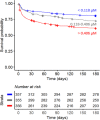This is a preprint.
Tryptophan metabolism determines outcome in tuberculous meningitis: a targeted metabolomic analysis
- PMID: 36711829
- PMCID: PMC9882445
- DOI: 10.1101/2023.01.08.23284316
Tryptophan metabolism determines outcome in tuberculous meningitis: a targeted metabolomic analysis
Update in
-
Tryptophan metabolism determines outcome in tuberculous meningitis: a targeted metabolomic analysis.Elife. 2023 May 9;12:e85307. doi: 10.7554/eLife.85307. Elife. 2023. PMID: 37158692 Free PMC article.
Abstract
Background: Cellular metabolism is critical for the host immune function against pathogens, and metabolomic analysis may help understand the characteristic immunopathology of tuberculosis. We performed targeted metabolomic analyses in a large cohort of patients with tuberculous meningitis (TBM), the most severe manifestation of tuberculosis, focusing on tryptophan metabolism.
Methods: We studied 1069 Indonesian and Vietnamese adults with TBM (26.6% HIV-positive), 54 non-infectious controls, 50 with bacterial meningitis, and 60 with cryptococcal meningitis. Tryptophan and downstream metabolites were measured in cerebrospinal fluid (CSF) and plasma using targeted liquid chromatography mass-spectrometry. Individual metabolite levels were associated with survival, clinical parameters, CSF bacterial load and 92 CSF inflammatory proteins.
Results: CSF tryptophan was associated with 60-day mortality from tuberculous meningitis (HR=1.16, 95%CI=1.10-1.24, for each doubling in CSF tryptophan) both in HIV-negative and HIV-positive patients. CSF tryptophan concentrations did not correlate with CSF bacterial load nor CSF inflammation but were negatively correlated with CSF interferon-gamma concentrations. Unlike tryptophan, CSF concentrations of an intercorrelating cluster of downstream kynurenine metabolites did not predict mortality. These CSF kynurenine metabolites did however correlate with CSF inflammation and markers of blood-CSF leakage, and plasma kynurenine predicted death (HR 1.54, 95%CI=1.22-1.93). These findings were mostly specific for TBM, although high CSF tryptophan was also associated with mortality from cryptococcal meningitis.
Conclusion: TBM patients with a high baseline CSF tryptophan or high systemic (plasma) kynurenine are at increased risk of mortality. These findings may reveal new targets for host-directed therapy.
Funding: This study was supported by National Institutes of Health (R01AI145781) and the Wellcome Trust (110179/Z/15/Z and 206724/Z/17/Z).
Figures





References
-
- Wilkinson RJ, Rohlwink U, Misra UK, et al. Tuberculous meningitis. Nat Rev Neurol 2017; 13: 581–98. - PubMed
-
- Laarhoven A van, Dian S, Aguirre-Gamboa R, et al. Cerebral tryptophan metabolism and outcome of tuberculous meningitis: an observational cohort study. The Lancet Infectious Diseases 2018; 18: 526–35. - PubMed
-
- Laarhoven A van, Dian S, Ruesen C, et al. Clinical Parameters, Routine Inflammatory Markers, and LTA4H Genotype as Predictors of Mortality Among 608 Patients With Tuberculous Meningitis in Indonesia. J Infect Dis 2017; 215: 1029–39. - PubMed
Publication types
Grants and funding
LinkOut - more resources
Full Text Sources
